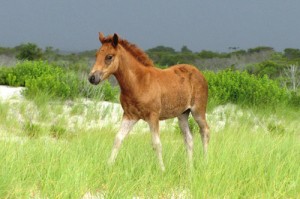
ASSATEAGUE — The online auction bidding for the naming rights of the only foal born on Assateague this year was wildly successful once again with the successful bid coming in at over $3,000.
Each year, the Assateague Island Alliance (AIA) holds various contests and auctions for the naming rights of new foals born into the herd of wild ponies on the barrier island. This year, the AIA offered an opportunity to leave a lasting legacy with the wild horses on Assateague with its charitable eBay auction for the naming rights of the only foal born in the Maryland herd in 2013.
The new foal, currently identified only as N9BFQ-GL, was birthed by Harmony in a remote part of the island far from the developed north end in May and is in need of a common, less formal name. In the mid-1970s, the National Park Service began naming new foals in the Assateague herd with an alpha-numeric code to help track the lineage and ancestry of the wild horses and identify which sub-herd they belong to and the areas they frequent on the island.
However, the AIA, through its Adopt a Horse program, began holding various contests and auctions to provide residents and visitors with the right to name the new foals added to the herd each year. To that end, the AIA this month hosted an eBay auction for the naming rights for N9BFQ-GL. The online Name That Foal online auction opened on Dec. 6 with a minimum mandatory bid of $300.
The auction ended last Sunday with the successful bidder coming in at $3,070. Throughout the 10-day online auction, the bids climbed steadily from the initial $300 to the final $3,070. The name of the successful bidder has not been made public, nor has the new name chosen for N9BFQ-GL been announced. The proceeds from the auction benefit the AIA, the friends group of the Assateague Island National Seashore.
While in some years multiple foal-naming auctions are held, the foal up for bid this month was the only one whose naming rights will be auctioned this year. The island’s wild pony population now stands at around 115, a figure considerably lower than a decade ago, but still far from the target range of 80 to 100.
While three to five foals are added to the herd in a typical year, an in-kind number drop off due to old age, illness or other natural or man-made factors. The mortality rate is around three to five percent, meaning three to five out of 100 are lost each year to attrition, which corresponds to the three to five new foals birthed each year.
In the interest of managing the size of the herd, which, if left unchecked would overtake the barrier island and gobble up the very resources the wild ponies need to survive, the National Park Service several years ago began a contraceptive program for the mares in the herd. The mares are injected with a non-invasive contraceptive to prevent multiple births in an effort to maintain and ultimately shrink the size of the herd to its manageable threshold.
In the interest of maintaining the gene pool of the famous wild ponies, believed to be descendants of domesticated horses placed on the island 300 years ago, each mare is allowed to birth one foal before being put on the contraceptive program.
